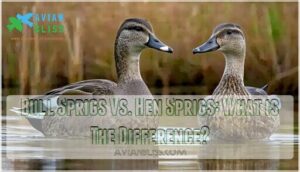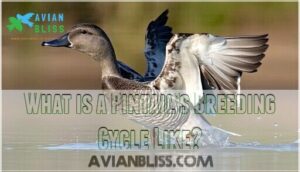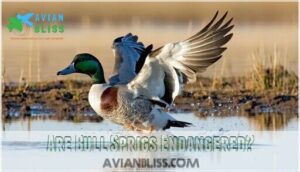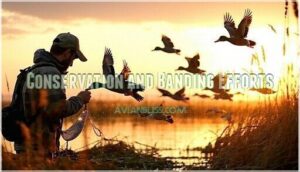This site is supported by our readers. We may earn a commission, at no cost to you, if you purchase through links.
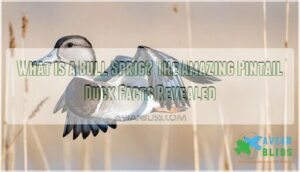
The term "bull" indicates it’s a mature male, while "sprig" comes from their tail’s resemblance to a plant shoot. These ducks earn the nickname "Greyhounds of the Air" because they’re incredibly fast fliers.
Bull sprigs are larger and more colorful than females, sporting chocolate-brown heads with white chest stripes during breeding season. They’re different from young pintails called "spriglets" and females known as "hen sprigs."
Understanding these naming conventions reveals fascinating details about pintail behavior and identification.
Table Of Contents
- Key Takeaways
- What is a Bull Sprig and Where Does The Name Come From?
- How to Identify a Bull Sprig?
- Where Do Bull Sprigs Live?
- How Long Do Bull Sprigs Live For?
- What is a Pintail’s Breeding Cycle Like?
- What Do Bull Sprigs Eat?
- What is So Unique About Northern Pintails?
- Are Bull Sprigs Endangered?
- Can You Raise Pintails as Pets?
- Conservation and Banding Efforts
- Frequently Asked Questions (FAQs)
- Conclusion
Key Takeaways
- You’ll recognize a bull sprig as an adult male Northern Pintail duck with a chocolate-brown head, white chest stripe, and distinctive long pointed tail feathers that give them their "sprig" nickname.
- You can distinguish bull sprigs from females (hen sprigs) by their vibrant breeding plumage and larger size, while females display mottled brown coloring and handle all nesting duties alone.
- You’ll find these "Greyhounds of the Air" flying at speeds up to 48 mph across North America, from Alaska to Mexico, with impressive migration distances of up to 1,800 miles nonstop.
- You can’t legally keep bull sprigs as pets since they’re protected migratory birds, and their populations face serious threats from habitat loss, with numbers dropping by over seven million birds since the 1980s.
What is a Bull Sprig and Where Does The Name Come From?
You’ve probably heard hunters and bird watchers use the term "bull sprig", but it’s simply the name for an adult male Northern Pintail duck.
The name comes from combining "bull" to show it’s a mature male and "sprig" which refers to the duck’s long, pointed tail feathers that look like a thin branch or sprig.
What is a Young Pintail Duck Called?
Young Northern Pintail ducklings don’t carry fancy titles until they reach maturity. Both male and female youngsters are simply called ducklings or juvenile pintails during their first 240 days of life.
This duckling development period is vital for establishing their identity. You won’t hear biologists using special naming conventions for young females beyond "juvenile pintails."
The sprig age classification only applies once they’ve developed their adult features and can be properly sexed. Maturity indicators like full juvenile plumage development help determine when a young duck shifts from duckling to adult status.
The terms "bull sprig" for males and "hen sprig" for females are reserved for mature Northern Pintail ducks who’ve earned their adult feathers and distinctive characteristics.
What is a Female Pintail Called, Then?
Now that you know what young pintails are called, let’s talk about the ladies of the species. Female Northern Pintail (Anas acuta) identification is straightforward once you understand the naming system.
Here’s what makes hen sprig ID distinct from their bull sprig counterparts:
- Female plumage appears mottled brown and tan, lacking the male’s flashy colors
- Juvenile pintails of both sexes look similar to adult females initially
- Female behavior includes fierce nest defense while males abandon after mating
- Nesting differences show hens choosing open grasslands far from water
- Bills stay black year-round, unlike males’ colorful seasonal changes
The term "hen" is used for most female birds, including pintails.
How to Identify a Bull Sprig?
You’ll recognize a bull sprig by its chocolate brown head with a white neck stripe and those distinctive long, pointed tail feathers that make it stand out from other ducks.
Those elegant tail feathers aren’t just for show – they’re the signature feature that gives these ducks their "sprig" nickname.
Look for the gray body, white breast, and slate blue bill with a black tip to confirm you’re seeing an adult male Northern Pintail with a distinctive appearance.
What Do Pintail Ducks Look Like?
Spotting a Northern Pintail duck becomes easy once you know what to look for.
These sleek birds showcase remarkable differences between males and females.
Male plumage features a chocolate-brown head with distinctive white neck stripes running down to their bright white breast.
Their gray bodies contrast beautifully with long, pointed black tail feathers that give them their "sprig" nickname.
You’ll notice their slate-blue bills tipped with black.
Female plumage appears more subdued, with mottled brown and tan coloring throughout.
Juvenile appearance mimics females until males develop their striking adult colors.
Regional variations exist, but these core features remain consistent.
Molting patterns change their look seasonally, with males losing their vibrant characteristics during summer eclipse plumage.
Bull Sprigs Vs. Hen Sprigs: What is The Difference?
How can you tell a bull sprig from a hen sprig? The plumage comparison reveals striking size differences – males sport chocolate heads with white neck stripes, while females display mottled brown feathers.
Call variation helps too: bulls whistle softly, hens quack nasally.
Behavior contrasts emerge during breeding when parental roles divide – Northern Pintail duck females handle nesting duties alone, and this distinction is crucial for understanding the breeding habits of these birds.
Where Do Bull Sprigs Live?
Bull sprigs call North America their home, with their range stretching from Alaska down to Mexico. You’ll find these graceful ducks in shallow wetland areas, flooded agricultural fields, and prairie potholes throughout their territory.
During breeding season, they prefer nesting habitats in Canada and the northern United States, particularly around marshes and pond edges. Migration patterns take bull sprigs on impressive journeys twice yearly.
They head to wintering grounds across the southern U.S. and Mexico when temperatures drop. The Prairie Pothole region serves as their primary breeding area, though habitat threats from agricultural development continue to challenge their populations.
These adaptable ducks don’t stick to one wetland type. You might spot them in temporary pools, permanent marshes, or even coastal areas. Consider their distribution when observing pintails.
Range expansion has occurred in some regions, but overall habitat loss remains a concern for maintaining healthy bull sprig populations across North America.
How Long Do Bull Sprigs Live For?
Where bull sprigs call home directly impacts their wild lifespan expectations. These elegant ducks face a sobering reality – most live just 3 years on average in natural settings, though some remarkable individuals reach 27 years through banding studies.
Their tail feathers and graceful flight can’t shield them from harsh truths:
- Only half of all ducklings survive their first migration
- Habitat loss destroys critical feeding and nesting areas
- Hunting pressure during seasonal movements takes its toll
- Pollution in flooded agricultural fields affects their health
- Climate change threatens Arctic breeding grounds
Factors affecting longevity include migration distance, predation risks, and environmental threats. Biologists involved in duck banding efforts track these factors to learn more about duck populations. Captive lifespan averages higher at 10-15 years due to protection from these dangers.
What is a Pintail’s Breeding Cycle Like?
Every spring, Northern Pintail breeding cycles begin with spectacular mating displays that’ll leave you amazed.
Bull sprig drakes perform elaborate courtship rituals, stretching their necks and whistling to attract mates during pair bonding season.
Once paired, these devoted couples migrate together to nesting grounds. The hen’s nesting habits are fascinating—she builds shallow ground nests up to 1.2 miles from water, often choosing croplands or grasslands for better predator visibility.
She lays 7-9 pale olive eggs, then begins her dedicated incubation period of 22-24 days. During this time, the male abandons his mate to join bachelor flocks. The female rarely leaves her nest, turning eggs multiple times daily to guarantee proper development.
When ducklings hatch synchronously, duckling survival depends on the mother’s fierce protection as she leads them to wetland feeding areas within hours. These nests are often found in sparse vegetation areas.
What Do Bull Sprigs Eat?
Now that you understand their breeding habits, you’re probably curious about what fuels these elegant waterfowl throughout the year.
Bull sprigs are omnivorous dabbling ducks with fascinating dietary adaptations that change with the seasons.
During winter months, their diet consists primarily of aquatic plants like pondweed, widgeon grass, and various seeds.
However, their seasonal diet shifts dramatically during breeding season when nutritional needs increase.
Bull sprigs then focus on protein-rich foods including aquatic insects, mollusks, and small crustaceans to build the strength needed for courtship and reproduction.
Their foraging behavior involves tipping up in shallow water, using their long necks to reach food up to 12 inches below the surface.
This prey selection strategy gives them access to more diverse food sources than shorter-necked ducks.
They’re also opportunistic feeders, often grazing on waste grains in agricultural fields during migration.
What is So Unique About Northern Pintails?
Among all waterfowl species, Northern Pintail ducks possess remarkable traits that’ll make you appreciate these incredible birds even more.
These elegant creatures stand out through their exceptional abilities and distinctive characteristics that set them apart from other ducks.
Here’s what makes bull sprig and other pintail ducks truly special:
- Rapid Flight – They’re the "Greyhounds of the Air," reaching speeds up to 48 mph with their streamlined bodies and narrow wings
- Long Migrations – These birds can fly nonstop for 1,800 miles between breeding and wintering grounds
- Feeding Habits – Unlike most ducks, they’re primarily nocturnal foragers, making them uniquely adapted hunters
- Courtship Displays – Males perform elaborate group "pursuit flights" with soft whistling calls during breeding season
Their exceptional flight capabilities, combined with their cautious nature and distinctive appearance, make Northern Pintails one of nature’s most remarkable waterfowl species.
Are Bull Sprigs Endangered?
Despite their graceful flight and widespread distribution, Northern Pintail populations face serious challenges that put bull sprig numbers at risk.
While not officially listed as endangered species, these ducks have experienced dramatic population decline over the past four decades.
Conservation Status reports show breeding populations dropped by over seven million birds since the 1980s.
Population Trends reveal concerning annual decline rates of 6.17% from 1966 to 2017, with recent years showing even steeper drops.
Habitat Loss drives much of this decline, as prairie grasslands converted to cropland eliminated over 75% of native nesting areas.
Climate Change compounds these problems through increased drought conditions that reduce breeding success.
While Northern Cardinals are considered "Least Concern," pintails face greater threats from habitat loss and change.
Hunting Impact remains regulated, but combined pressures strain pintail recovery efforts.
Conservation groups work tirelessly to restore wetlands and protect remaining habitats.
You can help by supporting habitat restoration programs that give these magnificent birds a fighting chance for survival.
Can You Raise Pintails as Pets?
You can’t legally keep pintails as pets in most places.
Federal wildlife laws protect these migratory birds, making domestication nearly impossible without special permits reserved for conservation work.
Even if legality wasn’t an issue, pintails make terrible pet animals.
These wild ducks have specific needs that enclosed spaces simply can’t meet:
- Housing Needs: They require vast wetlands spanning thousands of acres, not backyard ponds
- Dietary Requirements: Their complex foraging behavior can’t be replicated with commercial feed alone
- Socialization: They need massive flocks and seasonal migration patterns for mental well-being
Pet suitability for pintails is virtually zero.
Their skittish nature means they’ll injure themselves trying to escape confinement.
The ethical concerns are significant too – keeping these "greyhounds of the air" caged denies their fundamental need to migrate across continents.
Appreciate pintails where they belong: soaring free across wetland skies.
Conservation and Banding Efforts
While keeping pintails as pets isn’t realistic, you can still make a real difference for wild populations through conservation efforts.
Northern Pintail numbers have dropped substantially over recent decades, making wildlife conservation more important than ever.
Duck banding programs provide the backbone for tracking these birds across their migration routes. When researchers attach small metal bands to pintails, they gather valuable banding data that reveals population trends and survival rates.
This information directly influences hunting regulations and habitat preservation decisions.
Here are three key conservation strategies protecting bull sprigs:
- Habitat Preservation – Protecting wetlands and grasslands where pintails breed and feed
- Population Monitoring – Using banding data to track numbers and migration patterns
- Climate Impacts – Addressing drought and weather changes affecting nesting success
Your support for conservation organizations helps guarantee these graceful "greyhounds of the air" continue gracing our skies for future generations.
Frequently Asked Questions (FAQs)
How fast can bull sprigs fly?
Bull sprigs reach impressive speeds of 48 mph, earning them the nickname "Greyhounds of the Air."
You’ll find these aerodynamic ducks among North America’s fastest waterfowl, capable of flying up to 1,800 miles nonstop during migration.
What sounds do bull sprigs make?
You’ll hear bull sprigs produce soft, two-toned whistles during courtship displays. These distinctive bell-like calls include rolling trills that make them easily recognizable among other waterfowl during breeding season.
When do pintails migrate south annually?
These graceful birds travel up to 1,800 miles nonstop during fall migration.
You’ll see pintails heading south from September through November, with most departing their northern breeding grounds by mid-October for warmer wintering areas.
How many eggs do hen sprigs lay?
When you’re observing hen sprigs during breeding season, you’ll find they typically lay 6 to 12 eggs per clutch. Most commonly, they’ll produce around 7 to 9 greenish-buff colored eggs in their nests.
What threatens bull sprig populations most?
You’ll find habitat loss poses the biggest threat to bull sprig populations.
Wetland drainage, agricultural expansion, and climate change destroy their nesting grounds.
Hunting pressure and predation also impact numbers, but habitat destruction remains their primary challenge.
Conclusion
Picture spotting a sleek duck with a needle-like tail slicing through the sky at 65 mph – you’ve just witnessed a bull sprig in action.
Now you know what’s a bull sprig: an adult male Northern Pintail duck with remarkable speed and distinctive features.
You’ll easily identify these "Greyhounds of the Air" by their chocolate-brown heads, white chest stripes, and signature pointed tails.
Understanding bull sprig terminology helps you appreciate these magnificent waterfowl and their unique place in nature’s ecosystem.
- https://www.birdwatchingdaily.com/beginners/birding-faq/what-is-a-bull-sprig/
- https://www.streemfire.com/duckhuntingtv/pintail-hen-vs-drake
- https://www.fieldandstream.com/stories/hunting/waterfowl-hunting/duck-sounds
- https://www.ducks.org/conservation/national/saving-the-sprig
- https://www.rspb.org.uk/birds-and-wildlife/wildlife-guides/bird-a-z/pintail/


